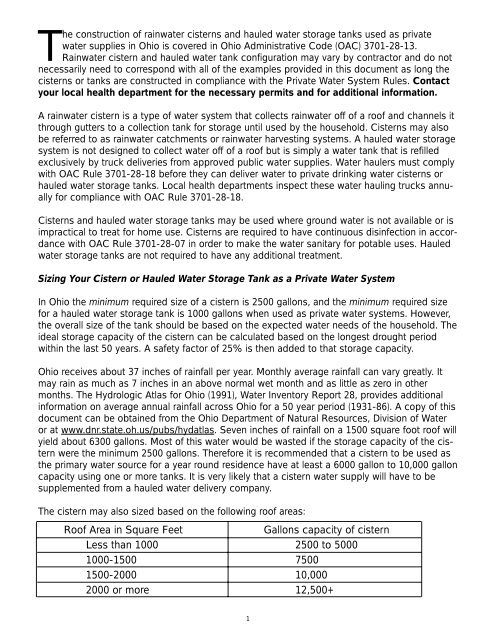Plans for Developing a Rainwater Cistern or Hauled Water ... - ATSDR
Plans for Developing a Rainwater Cistern or Hauled Water ... - ATSDR
Plans for Developing a Rainwater Cistern or Hauled Water ... - ATSDR
You also want an ePaper? Increase the reach of your titles
YUMPU automatically turns print PDFs into web optimized ePapers that Google loves.
The construction of rainwater cisterns and hauled water st<strong>or</strong>age tanks used as private<br />
water supplies in Ohio is covered in Ohio Administrative Code (OAC) 3701-28-13.<br />
<strong>Rainwater</strong> cistern and hauled water tank configuration may vary by contract<strong>or</strong> and do not<br />
necessarily need to c<strong>or</strong>respond with all of the examples provided in this document as long the<br />
cisterns <strong>or</strong> tanks are constructed in compliance with the Private <strong>Water</strong> System Rules. Contact<br />
your local health department <strong>f<strong>or</strong></strong> the necessary permits and <strong>f<strong>or</strong></strong> additional in<strong>f<strong>or</strong></strong>mation.<br />
A rainwater cistern is a type of water system that collects rainwater off of a roof and channels it<br />
through gutters to a collection tank <strong>f<strong>or</strong></strong> st<strong>or</strong>age until used by the household. <strong>Cistern</strong>s may also<br />
be referred to as rainwater catchments <strong>or</strong> rainwater harvesting systems. A hauled water st<strong>or</strong>age<br />
system is not designed to collect water off of a roof but is simply a water tank that is refilled<br />
exclusively by truck deliveries from approved public water supplies. <strong>Water</strong> haulers must comply<br />
with OAC Rule 3701-28-18 be<strong>f<strong>or</strong></strong>e they can deliver water to private drinking water cisterns <strong>or</strong><br />
hauled water st<strong>or</strong>age tanks. Local health departments inspect these water hauling trucks annually<br />
<strong>f<strong>or</strong></strong> compliance with OAC Rule 3701-28-18.<br />
<strong>Cistern</strong>s and hauled water st<strong>or</strong>age tanks may be used where ground water is not available <strong>or</strong> is<br />
impractical to treat <strong>f<strong>or</strong></strong> home use. <strong>Cistern</strong>s are required to have continuous disinfection in acc<strong>or</strong>dance<br />
with OAC Rule 3701-28-07 in <strong>or</strong>der to make the water sanitary <strong>f<strong>or</strong></strong> potable uses. <strong>Hauled</strong><br />
water st<strong>or</strong>age tanks are not required to have any additional treatment.<br />
Sizing Your <strong>Cistern</strong> <strong>or</strong> <strong>Hauled</strong> <strong>Water</strong> St<strong>or</strong>age Tank as a Private <strong>Water</strong> System<br />
In Ohio the minimum required size of a cistern is 2500 gallons, and the minimum required size<br />
<strong>f<strong>or</strong></strong> a hauled water st<strong>or</strong>age tank is 1000 gallons when used as private water systems. However,<br />
the overall size of the tank should be based on the expected water needs of the household. The<br />
ideal st<strong>or</strong>age capacity of the cistern can be calculated based on the longest drought period<br />
within the last 50 years. A safety fact<strong>or</strong> of 25% is then added to that st<strong>or</strong>age capacity.<br />
Ohio receives about 37 inches of rainfall per year. Monthly average rainfall can vary greatly. It<br />
may rain as much as 7 inches in an above n<strong>or</strong>mal wet month and as little as zero in other<br />
months. The Hydrologic Atlas <strong>f<strong>or</strong></strong> Ohio (1991), <strong>Water</strong> Invent<strong>or</strong>y Rep<strong>or</strong>t 28, provides additional<br />
in<strong>f<strong>or</strong></strong>mation on average annual rainfall across Ohio <strong>f<strong>or</strong></strong> a 50 year period (1931-86). A copy of this<br />
document can be obtained from the Ohio Department of Natural Resources, Division of <strong>Water</strong><br />
<strong>or</strong> at www.dnr.state.oh.us/pubs/hydatlas. Seven inches of rainfall on a 1500 square foot roof will<br />
yield about 6300 gallons. Most of this water would be wasted if the st<strong>or</strong>age capacity of the cistern<br />
were the minimum 2500 gallons. There<strong>f<strong>or</strong></strong>e it is recommended that a cistern to be used as<br />
the primary water source <strong>f<strong>or</strong></strong> a year round residence have at least a 6000 gallon to 10,000 gallon<br />
capacity using one <strong>or</strong> m<strong>or</strong>e tanks. It is very likely that a cistern water supply will have to be<br />
supplemented from a hauled water delivery company.<br />
The cistern may also sized based on the following roof areas:<br />
Roof Area in Square Feet Gallons capacity of cistern<br />
Less than 1000 2500 to 5000<br />
1000-1500 7500<br />
1500-2000 10,000<br />
2000 <strong>or</strong> m<strong>or</strong>e 12,500+<br />
1

















